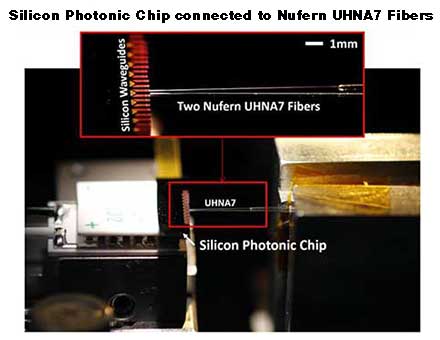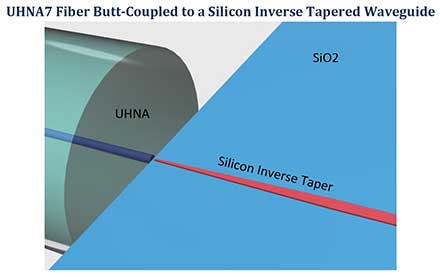Full company details
Nufern
A Coherent Co.
 7 Airport Park Rd.
7 Airport Park Rd.
East Granby, CT 06026
Phone: +1 860-408-5000
Toll-free: +1 866-466-0214
Application Note: UHNA Fiber – Efficient Coupling to Silicon Waveguides
Dr. Stefan Preble, Rochester Institute of Technology
Introduction
The small mode field diameter of Nufern’s Ultra-High Numerical Aperture (UHNA) fibers enables very efficient coupling to Silicon waveguides. In addition, UHNA can be fusion spliced directly to SMF28, providing a low-loss bridge from SMF28-to-Silicon with an overall coupling loss of less than 1.5dB (per connection)
1,2,3

Two UHNA7 Fibers butt-coupled to Silicon Waveguides. The chip contains dozens of waveguide devices and the overall coupling loss (from laser to detector) between any input/output waveguide combination is measured to be <3dB. Image Courtesy of Stefan Preble - Rochester Institute of Technology.
Efficient Coupling to Silicon Waveguides
Silicon Photonics is enabling the next generation of high performance transceivers by using standard integrated circuit manufacturing processes. The technology is also beginning to be used for a wide range of emerging applications, such as biological/chemical sensing, RF signal processing and optical interconnects. All of these applications require efficient coupling between traditional SMF28 fibers and the Silicon waveguides.
Nufern’s series of UHNA fibers provide a low loss coupling interface to the small modes of Silicon waveguides. Specifically, the 3.2µm mode field diameter of UHNA7 closely matches the mode of an inverse tapered Silicon waveguide, which transitions from a ~150nm tip to a strongly confined single mode Silicon waveguide [width of ~500nm]. The cleaved UHNA7 fiber can be simply butt-coupled against a suitably prepared chip facet (cleaved, polished or etched) to achieve optimal coupling. By applying a modest force against the facet it is possible to maintain coupling indefinitely without any active feedback.

Optimal coupling was realized with an inverse taper with a 150nm wide tip transitioned to a final width of 500nm over 300µm length. The silicon is 220nm thick and the chip has a buried oxide of 3µm and is also clad with 3µm of SiO2 (not shown).
Fusion Splicing UHNA to SMF28
Any small mode field diameter fiber would normally pose a problem with coupling to a larger mode field diameter fiber such as SMF28 because of the mismatch. The UHNA series of fibers solves this problem with a fiber core that will thermally expand upon fusion splicing. This expansion of the UHNA core allows the UHNA mode field to better match the mode field of larger core diameter fibers, creating an adiabatic taper in the UHNA fiber beginning at the splice point and decreasing back into the UHNA. This effective taper results in very high coupling efficiency between the two fibers and very low splice losses.

To achieve these low loss splices (0.1-0.2 dB loss), the splicing of UHNA fibers requires special treatment compared with standard optical fibers, namely a very long arc time to produce the proper length taper in the UHNA core. A splicing recipe that has been successful on a Fujikura FSM40S is as follows:
 Summary:
Summary:
This application note has provided details on using Nufern’s Ultra-High NA optical fibers as a low loss bridge from SMF28 to Silicon waveguides, including, a simple Silicon waveguide mode converter design and fusion splicing parameters that will minimize overall coupling loss.
 References
References
1. S. F. Preble, M.L. Fanto, J.A. Steidle, C.C. Tison, G.A. Howland, E.E. Hach III, Z. Wang, P.M. Alsing, “On-chip quantum interference from a single silicon ring-resonator source,” Physical Review Applied 4, 021001 (2015).
2. J.A. Steidle, M. L. Fanto, C. C. Tison, Z. Wang, S. F. Preble, P. M. Alsing, High spectral purity silicon ring resonator photon-pair source, SPIE DSS 2015, Baltimore, MD (2015).
3. Data provided by Dr. Stefan Preble of the Rochester Institute of Technology.
Nufern offers a wide range of specialty fibers for industrial, medical, military, aerospace and scientific applications.
Our ongoing commitment to research and investigation with our customers promises a bright future with optical fiber technology.
We look forward to hearing from you.
Nufern Customer Service
860-408-5000
Request Info